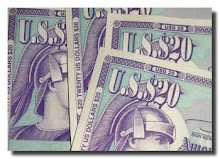Why the Forex Market ChangedThrough the 1980s and 1990s, and even into the new century, the distinctive characteristic of the foreign exchange market was its volatility—a volatility that was a reflection of major imbalances between national economies. When a country over-spent or over-borrowed, or when its external trade went wildly out of balance, its interest rates were forced up and its economic growth slowed down. In the forex market, the country's currency also paid the price—usually by sudden and sometimes drastic devaluation. In short, economic imbalance generated currency volatility.
Increasing globalization has changed all that. In today's world of tightening economic interdependency, it is in every country's interest to maintain economic and financial stability—even if it costs. Countries with a trade surplus (in particular China) now effectively underwrite countries with a trade deficit (in particular the US) in the name of stability and an orderly market. As a result, interest rate differences are compressed and currency volatility is minimized.
The New Range-Bound Forex MarketThe forex market has undergone a profound change. In past years, a trade imbalance or an interest rate shift could suddenly move a currency price hundreds of pips. For that reason, success in the forex market followed a traditional formula: Cut your losses short, but let your profits run. Traders took small losses quickly, but rode big trends for big wins. A volatile forex market rewarded breakout traders.
Using that formula, professional traders were disciplined enough (or their black boxes were disciplined enough) to absorb several small losing trades, because their one, very large win more than made up for them. Using a breakout trading system, only 30% of the trades had to be winners, because the payoff on a breakout trade could be six times the total of the losses. The risk/reward ratio and the mathematical probabilities were in their favor.
How to Trade in the New Forex Market—With the New MathRecently, however, traders have been searching in vain for that kind of explosive breakout market. Thanks to the new interconnected, stability-first world, the formula, the market—and the mathematics—have all changed. Forex is no longer a market in which the trader can exploit volatility. (Our best estimate is that volatility in the major currency pairs has fallen over 50% in the last three years.) Unfortunately, too many traders—even professionals with years of experience—have been slow to adjust, and have paid the price. Accumulating a half-years' worth of small losses (by continually being stopped out), they can no longer make up those losses, because the huge breakout they need is not there.
Instead, in a market where the price moves inside a support-resistance tunnel, it can be possible for the trader to profit by overwhelming one major losing trade with several small ones. The new math says that by trading in a range, 90% of the trades can be winners offsetting losing trades, and that a 200-pip loss can be more than offset by a collection of 30-pip wins, taken by harvesting tops and bottoms as the price oscillates inside its price tunnel. No matter which way the currency price travels, its natural tendency is to move back and forth inside defined price channels. The trader takes small profits quickly, sets up generous 200-pip holds to avoid being stopped out, and waits for the price to retrace.
Trading foreign exchange on margin carries a high level of risk, and may not be suitable for all investors. The high degree of leverage can work against you as well as for you. Before deciding to trade foreign exchange you should carefully consider your investment objectives, level of experience, and risk appetite. The possibility exists that you could sustain a loss of some or all of your initial investment and therefore you should not invest money that you cannot afford to lose. You should be aware of all the risks associated with foreign exchange trading, and seek advice from an independent financial advisor if you have any doubts.
Using Buy/Sell Signals to Exploit the New Forex MarketThe Buy/Sell Signals system is the only trading tool designed specifically for today's range-bound forex market. In constructing the system, the FXCM Research Group incorporated those technical indicators that have demonstrated the highest reliability in pinpointing currencies with a natural tendency to move back and forth inside price channels for weeks and sometimes months at a time.
A computer-generated automatic signal system, Buy-Sell Signals alert you as to which currency pair is in ranging mode, withClear, unambiguous trade ideas—for short, medium and long-term strategies;Real-time entry and exit points to aid you in buying at support and selling at resistance;Precise stop/limit levels.
Another advantage of a range-bound trading strategy is that it offers more trading opportunities for any trading schedule. Almost always one or another currency pair is in a ranging market. And since Buy-Sell Signals are updated continually around the clock, you can find trade ideas on your own time schedule, and remote control your trading with built-in stops and limits.
Buy/Sell Forex Signals for Ranging Markets
Friday, December 21, 2007 At: 12/21/2007 09:05:00 AM by Joyce.gardner
Foreign
Exchange Calculator
|
||||||||
|
| Conversion : What do you want to convert to? |
Rates as of Fri Feb 29 18:05:03 EST 2008
Note: Rates may change throughout the day and may differ at the time
of booking. These rates apply to foreign exchange transactions with the
exception of the purchase and sale of currency notes (cash).

